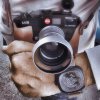Photoshop Gurus Forum
Welcome to Photoshop Gurus forum. Register a free account today to become a member! It's completely free. Once signed in, you'll enjoy an ad-free experience and be able to participate on this site by adding your own topics and posts, as well as connect with other members through your own private inbox!
You are using an out of date browser. It may not display this or other websites correctly.
You should upgrade or use an alternative browser.
You should upgrade or use an alternative browser.
*** Need help for technic to make photo like this****
- Thread starter comoco
- Start date
Dalkarls
Well-Known Member
- Messages
- 55
- Likes
- 42
I think you can pull this off rather easy by desaturating the picture, adding some slight blur to the edges and maybe making a new layer (Color blending mode) and paint some ares with a color. Finish it off with a contrast curve and boost vibrance.
The picture itself, I think is shot with a slighly wide angle lens.
Start working on your picture and we can give better tips on the way?
The picture itself, I think is shot with a slighly wide angle lens.
Start working on your picture and we can give better tips on the way?
Tom Mann
Guru
- Messages
- 7,222
- Likes
- 4,343
a) What software (and what version) do you intend to use to obtain this effect on your own photos?
b) In case you are wondering about Sam's comment, he is talking about many similar questions we have had over the past 6 months (or so). In most of those cases, the Topaz Adjust plugin is probably the easiest way to get the effect, e.g.:
http://www.photoshopgurus.com/forum/photoshop-newbies/43915-any-help-effect.html#post1533629512
http://www.photoshopgurus.com/forum...tool-technique-i-need-use.html#post1533648884
http://www.photoshopgurus.com/forum...-know-how-generate-effect.html#post1533643749
http://www.photoshopgurus.com/forum...os/46104-cartoon-effect-aka-topaz-effect.html
c) As Dalkarls suggested, there are ways to get a similar look without using any of the Topaz plugins, and in fact, the last link above shows another non-Topaz approach. I would add that using USM at medium radii will also help.
HTH,
Tom
b) In case you are wondering about Sam's comment, he is talking about many similar questions we have had over the past 6 months (or so). In most of those cases, the Topaz Adjust plugin is probably the easiest way to get the effect, e.g.:
http://www.photoshopgurus.com/forum/photoshop-newbies/43915-any-help-effect.html#post1533629512
http://www.photoshopgurus.com/forum...tool-technique-i-need-use.html#post1533648884
http://www.photoshopgurus.com/forum...-know-how-generate-effect.html#post1533643749
http://www.photoshopgurus.com/forum...os/46104-cartoon-effect-aka-topaz-effect.html
c) As Dalkarls suggested, there are ways to get a similar look without using any of the Topaz plugins, and in fact, the last link above shows another non-Topaz approach. I would add that using USM at medium radii will also help.
HTH,
Tom
Thank you for advices so far. But I think it is different from so called Topaz effect since Topaz has get rid of detail texture while my sample file is rich of it.
I will try what Dalkarls suggest in photoshop but if anyone has tutorial video, it would be best.
I will try what Dalkarls suggest in photoshop but if anyone has tutorial video, it would be best.
Thanks again.Tom Mann
Guru
- Messages
- 7,222
- Likes
- 4,343
@OP - There is a serious nomenclature problem associated with image efx like those in the image you cited. Many folks incorrectly call any effect vaguely similar to this "the Topaz look". This is out and out wrong. It completely ignores the fact that:
a) The effect may not have been executed using any Topaz product whatsoever;
b) There is no one identifiable "Topaz look". For example, 7 out of Topaz's current offering of 13 distinct products produce effects related to tonality, local contrast, sharpness and color. Each one of these have at least several adjustments to produce a wide range of efx even within just that one product, and, finally, even if one or more of the Topaz filters was used, efx of this sort are almost always done using a combination of the Topaz filters and Photoshop's native tools (and possibly other 3rd party plugins).
The image you cited is almost certainly a prime example of a combination of efx being used, and as Steve correctly pointed out, it's probably better described as one of the many variants of the Dragan look, not "the Topaz look".
That being said, you may find it informative to attempt to reverse engineer this image. In other words, use the efx "in reverse" to return the image to a state closer to what it might have looked like as it came out of the camera.
The 1st image below is just a copy of the image you posted. I include it for easy comparison to the other two images.
The 2nd image below is after I applied some fairly strong effects to the image in ACR and some minor tweaks in PS. No Topaz efx were used up to this point.
The 3rd image below is my second image after application of Topaz Detail with the adjustments set to strongly reduce large and medium scale local contrast, and enhance short range local contrast (aka, "sharpness"). The settings I used are shown in the 4th image below -- the screen grab.
When you mentioned "detail texture", you probably mean what most people are now calling "local contrast at medium length scales".
When discussing details of techniques, it is absolutely imperative to distinguish the various possible length scales. For sub-pixel to say 2 pixel regions, local contrast at this length scale is usually thought of as sharpness. For regions from tens to hundreds of pixels in size local contrast is usually thought of as what, in the old days, you would have got if you used USM with radius values in this range. Enhancement of contrast in regions between a couple of pixels and low tens of pixels in size are probably what you termed "detail texture".




In conclusion, it should be fairly obvious that the reverse of the last step (or something equivalent, eg, large radius USM) was used in the construction of the image you cited.
HTH,
Tom M
a) The effect may not have been executed using any Topaz product whatsoever;
b) There is no one identifiable "Topaz look". For example, 7 out of Topaz's current offering of 13 distinct products produce effects related to tonality, local contrast, sharpness and color. Each one of these have at least several adjustments to produce a wide range of efx even within just that one product, and, finally, even if one or more of the Topaz filters was used, efx of this sort are almost always done using a combination of the Topaz filters and Photoshop's native tools (and possibly other 3rd party plugins).
The image you cited is almost certainly a prime example of a combination of efx being used, and as Steve correctly pointed out, it's probably better described as one of the many variants of the Dragan look, not "the Topaz look".
That being said, you may find it informative to attempt to reverse engineer this image. In other words, use the efx "in reverse" to return the image to a state closer to what it might have looked like as it came out of the camera.
The 1st image below is just a copy of the image you posted. I include it for easy comparison to the other two images.
The 2nd image below is after I applied some fairly strong effects to the image in ACR and some minor tweaks in PS. No Topaz efx were used up to this point.
The 3rd image below is my second image after application of Topaz Detail with the adjustments set to strongly reduce large and medium scale local contrast, and enhance short range local contrast (aka, "sharpness"). The settings I used are shown in the 4th image below -- the screen grab.
When you mentioned "detail texture", you probably mean what most people are now calling "local contrast at medium length scales".
When discussing details of techniques, it is absolutely imperative to distinguish the various possible length scales. For sub-pixel to say 2 pixel regions, local contrast at this length scale is usually thought of as sharpness. For regions from tens to hundreds of pixels in size local contrast is usually thought of as what, in the old days, you would have got if you used USM with radius values in this range. Enhancement of contrast in regions between a couple of pixels and low tens of pixels in size are probably what you termed "detail texture".




In conclusion, it should be fairly obvious that the reverse of the last step (or something equivalent, eg, large radius USM) was used in the construction of the image you cited.
HTH,
Tom M
Steve
Retired Administrator
- Messages
- 7,868
- Likes
- 1,506
Glad to help.This is it!!!
thanks a lot Steve!!!
It is basically know as grunge effect.
Here's a link to the tutorial http://www.tricky-photoshop.com/grunge-portrait/
Here's a link to the tutorial http://www.tricky-photoshop.com/grunge-portrait/

